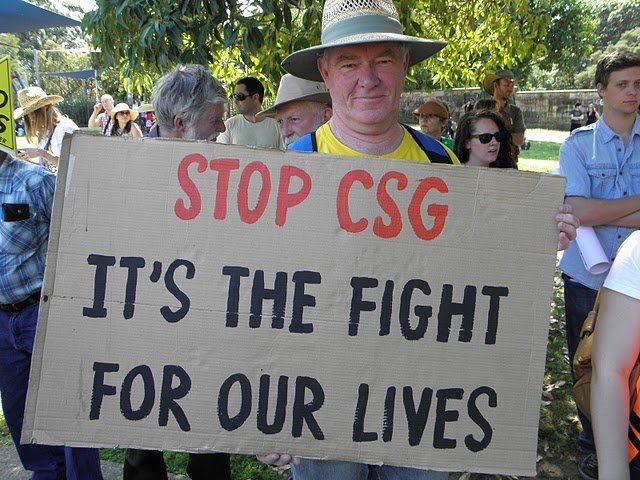
The development of the coal seam gas (CSG) industry brings risks to Australia’s limited water resources. It draws contaminated water out of the ground, damages aquifers and uses and pollutes large quantities of freshwater.
These risks, and the implications for health, agriculture and the environment, are central reasons for the growing community campaign to stop CSG mining.
Images in the documentary Gasland of people setting their tap water on fire have made many question the impact of unconventional gas on water supplies.
Yet research into the impacts of CSG — particularly in an Australian context — is very limited. CSG mining has been given the green light by state governments, but its full impacts are still unknown. That’s why the campaign against CSG calls for caution: an immediate moratorium and a Royal Commission into all aspects of the industry.
That said, documented cases of water contamination and international research into unconventional gas mining already show threats to water resources.
Produced water
Coal seams contain water as well as methane gas. In fact, it’s water pressure that keeps the gas trapped. So to mine the methane, water has to be drawn out of the coal seam.
This “produced water” is contaminated, as it has taken on some of the chemical properties of its surroundings. It is usually high in salt and can contain toxic and radioactive compounds, and heavy metals.
Hycap Energy’s 2010 study of CSG technologies in Wyoming also said large amounts of methane can come up in the produced water — on average, 15% of a well’s output. The concentration of methane can be so high that the water becomes flammable.
An article this year in the Proceedings of the National Academy of Sciences in the United States of America looked at the methane concentration in drinking water where unconventional gas drilling and fracking were happening.
It said: “In active gas-extraction areas (one or more gas wells within one kilometre), average and maximum methane concentrations in drinking-water wells increased with proximity to the nearest gas well” and reached concentrations that posed a potential explosion hazard.
This confirms not only methane contamination but also that produced water or methane is escaping into underground water systems as a result of drilling. CSG mining can create channels through which fugitive water and gas can flow into surrounding parts of the environment.
Fracking
Hydraulic fracturing or “fracking” is a stimulation process used in CSG mining. It involves the high-pressure injection of large volumes of water, directly contaminated with sand and chemicals, into the ground to fracture coal.
Fracking expands fissures in the coal seams, which allows gas to flow much faster and from a wider area. In fact, the experience of CSG mining in the US is that commercial viability depends on the extensive use of stimulation, such as hydraulic fracturing.
The CSG industry says a single well takes more than 11 million litres of water to fracture.
With 40,000 CSG wells proposed in Queensland alone, and estimates that 80% of wells will be fracked, CSG mining will be an enormous user of freshwater reserves.

Contamination risk
In April 2011, the US House of Representatives Committee on Energy and Commerce reported that formaldehyde, lead, hydrogen chloride, hydrogen fluoride and ethylene glycol were being used by hydraulic fracturing companies in the US.
A submission this year to the US Congress identified more than 750 different chemicals and compounds known to have been used in fracking. Most are not disclosed by CSG miners.
Likewise, in Australia there is no requirement for CSG companies to say what compounds will be added. The Australian Petroleum Production and Exploration Association (APPEA) lists only 20 of the 750 as in use in Australia.
However, contamination cases provide some information about what is in the fracking fluid.
For example, this year the Queensland government found the toxic chemicals benzene, toluene and xylene in 14 CSG wells run by Arrow Energy.
Research from Duke University found the recovery of fracking fluids varies from 15% to 80%, depending on well conditions. In other words, 20% to 85% of fracking fluids are released into the environment.
How much water?
The National Water Commission has estimated that the Australian CSG industry will extract about 7500 gigalitres (or 7500 billion litres) of co-produced water — that is, produced water and recovered drilling fluids — from underground systems over the next 25 years.
To put this in perspective, that’s more than 13 times the capacity of Sydney Harbour.
This water needs long-term containment or treatment, both of which bring more spillage risks. For example, in June 2009, about 5000 litres of drilling liquid overflowed from a tank at AGL’s Gloucester site.
Also, reverse osmosis — the most common treatment method for co-produced water — cannot remove all possible contaminants, only those larger than water molecules.
Further, additional clean water is being used to “purify” waste water. For example, AGL disposed of produced water at Camden by adding potable water to it until the discharge reached regulatory limits.
Aquifers
When water is drawn out of coal seams, it reduces water levels in surrounding groundwater systems. Even APPEA’s Ross Dunn has confirmed this. At a recent public meeting in Sydney he said: “Drilling will to varying degrees impact upon adjoining aquifers.”
Fugitive produced water, drilling fluids and methane can also escape into groundwater systems, contaminating aquifers. These changes in groundwater quantity and quality can damage ecosystems in Australia.
Countless plants rely on the availability of shallow groundwater; wetlands, estuaries and near-shore marine systems depend on them, and rivers can need them for base flow.
Moreover, many people and animals in Australia rely entirely on aquifers to provide their drinking water.
Comments
Anonymous replied on Permalink